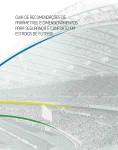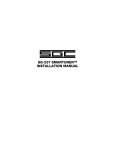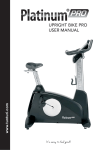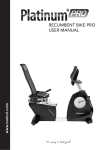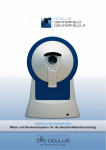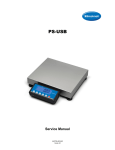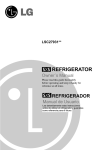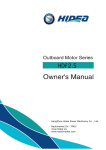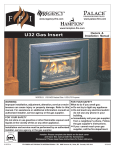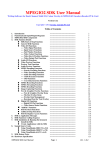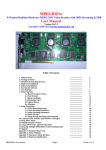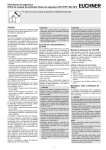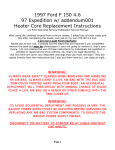Download Architectural Design Criteria 2006
Transcript
ARCHITECTURAL DESIGN CRITERIA TABLE OF CONTENTS I GENERAL................................................................................................................................3 II CRITERIA................................................................................................................................4 A. SITE REQUIREMENTS....................................................................................4 1. 2. 3. 4. 5. B. OUTDOOR ATHLETIC AND PLAY FACILITIES .......................................5 1. 2. 3. 4. 5. C. MATERIALS.............................................................................................................7 GENERAL REQUIREMENT ........................................................................................7 FULLY SPRINKLER ALL NEW BUILDINGS.................................................................7 BUILDINGS AND ENTRY ..........................................................................................7 BUILDING CIRCULATION ........................................................................................7 BUILDING(S) AND ENERGY .....................................................................................7 EXTERIOR DOORS ...................................................................................................8 HORIZONTAL SURFACES.........................................................................................8 ACOUSTICAL REQUIREMENTS ................................................................................8 WALLS ....................................................................................................................8 CEILINGS ................................................................................................................9 GOLF CART STORAGE/CHARGING AREA................................................................9 KITCHENS ...............................................................................................................9 TOILET ROOMS .......................................................................................................9 MAIN ELECTRICAL ROOM ....................................................................................10 CHEMICAL SCIENCE STORAGE ROOM ..................................................................10 SCIENCE ROOM EMERGENCY SHOWER/EYEWASH ...............................................10 ADMINISTRATION SUITE.......................................................................................10 CASEWORK/CABINETS ...............................................................................10 THERMAL AND MOISTURE PROTECTION ............................................10 1. 2. 3. 4. 5. 6. 7. F. GENERAL ................................................................................................................5 ELEMENTARY LEVEL ..............................................................................................5 MIDDLE SCHOOL LEVEL.........................................................................................5 HIGH SCHOOL LEVEL .............................................................................................6 DIMENSIONAL STANDARDS ....................................................................................6 BUILDING REQUIREMENTS.........................................................................7 1. 2. 3. 4. 5. 6. 7. 8. 9. 10. 11. 12. 13. 14. 15. 16. 17. 18. D. E. SITE DESIGN ...........................................................................................................4 VEHICULAR ACCESS AND OFF-STREET PARKING ...................................................4 COVERED WALKWAYS ...........................................................................................4 EXTERIOR SIGNAGE ................................................................................................4 SITE FURNISHINGS ..................................................................................................5 WATERPROOFING AND VAPOR BARRIERS ............................................................10 INSULATION ..........................................................................................................11 FIREPROOFING AND FIRESTOPPING/FIREBLOCKING .............................................11 JOINT SEALERS (TILT-UP WALLS)........................................................................11 ROOFING ...............................................................................................................11 FLASHING AND SHEET METAL .............................................................................12 ROOF SPECIALTIES AND ACCESSORIES ................................................................12 DOORS AND WINDOWS ...............................................................................12 1. 2. 3. GENERAL ..............................................................................................................13 DOORS AND FRAMES ............................................................................................13 WINDOWS .............................................................................................................14 Architectural Design Criteria School District Palm Beach County 2006 Edition 4/3/06 Page-1 of 32 4. 5. G. FINISHES..........................................................................................................16 1. 2. 3. 4. 5. H. AUDITORIUM SEATING .........................................................................................23 TELESCOPING BLEACHERS ...................................................................................24 SPECIAL CONSTRUCTION..........................................................................24 1. 2. L. APPLIANCES..........................................................................................................23 ATHLETIC EQUIPMENT .........................................................................................23 GYMNASIUM DIVIDERS ........................................................................................23 FURNISHING ...................................................................................................23 1. 2. K. INSTRUCTIONAL BOARDS .....................................................................................19 TOILET PARTITIONS AND PRIVACY SCREENS .......................................................20 WALL LOUVERS ...................................................................................................20 FLAGPOLES ...........................................................................................................20 IDENTIFYING DEVICES - SIGNS .............................................................................20 LOCKERS...............................................................................................................21 FIRE EXTINGUISHERS ...........................................................................................22 METAL SHELVING IN AREAS AS INDICATED IN ED SPECS ....................................22 TOILET ROOM ACCESSORIES ................................................................................22 EQUIPMENT....................................................................................................23 1. 2. 3. J. GENERAL ..............................................................................................................16 FLOOR FINISHES ...................................................................................................16 WALL FINISHES ....................................................................................................18 CEILING FINISHES .................................................................................................19 PAINT FINISHES ....................................................................................................19 SPECIALTIES ..................................................................................................19 1. 2. 3. 4. 5. 6. 7. 8. 9. I. FINISH HARDWARE ...............................................................................................15 GLAZING ...............................................................................................................16 HIGH SCHOOL STADIUMS .....................................................................................24 PORTABLE EXTERIOR BLEACHERS .......................................................................25 CONVEYING SYSTEMS ................................................................................25 1. 2. 3. GENERAL ..............................................................................................................25 PASSENGER ELEVATORS ......................................................................................25 WHEELCHAIR LIFTS..............................................................................................26 APPENDIX SOUND RATINGS.......................................................................................................................27 MOUNTING HEIGHTS..............................................................................................................28 HIGH SCHOOL APPLIANCES.................................................................................................29 MIDDLE SCHOOL APPLIANCES ...........................................................................................30 PRE_KELEMENTARY SCHOOL APPLIANCES ..................................................................30 ATHLETHIC FIELD DIMENSIONS ........................................................................................31 Architectural Design Criteria School District Palm Beach County 2006 Edition 4/3/06 Page-2 of 32 ARCHITECTURAL DESIGN CRITERIA I GENERAL A. The Design Professional shall use this document in conjunction with the Educational Specifications and District Master Specifications (DMS) to develop the design and contract documents. B. The Design Professional shall coordinate the work under this section with Civil, Electrical, Mechanical, Plumbing, and Structural Design Criteria. C. The Design Professional is encouraged to incorporate elements of the following in their designs: 1. Leadership in Energy and Environmental Design “LEED”/ "Green Architecture". 2. Safe school design principles using Crime Prevention Through Environmental Design “CPTED” and Florida Safe School Design Guidelines. 3. Use recycled products when practical and economically feasible, such as recycled plastic wheel stops or crushed recycled concrete road base. D. Goals: 1. Establish performance-oriented design standards to improve the function, appearance, and safety of the school campus. 2. Establish design guidelines that address architectural elements, building placement, tree preservation and “fit” within the community. 3. Make a positive and memorable statement to students, faculty, visitors and the community. 4. Be sensitive to existing neighbors and community. 5. Promote public health, safety, welfare and “love of learning”. E. This division contains requirements for the following elements. 1. Site Requirements 2. Outdoor Athletic and Play Facilities 3. Building Requirements 4. Casework/Cabinets 5. Thermal and Moisture Protection 6. Doors and Windows 7. Finishes, Floor, Wall, and Ceiling 8. Specialties 9. Equipment 10. Furnishing 11. Special Construction 12. Conveying Systems F. The Architect, or professional as defined by the Contract with the District, is the person responsible for the design and development of all project documents and the coordination of all consultants' documents. 1. In some case maybe a Professional Engineer, Construction Manager, or General Contractor. G. Design shall incorporate the latest design requirements and/or code requirements. 1. Florida Building Code (FBC) 2. Florida Fire Prevention Code (FFPC) 3. Educational Specifications (Ed Specs) 4. District Master Specs (DMS) H. Submittal requirements as listed in procedure BD-001 – Submission for Project Documents I. The Criteria shall not limit or restrain the performance and liability of the Professional or Professionals responsible for the integrity and performance of the structure. J. The Criteria is applicable to new construction and to the remodeling and renovation of existing facilities. K. The use of the Criteria in this document does not exempt the Design Professionals from any federal or state code or standards controlling the design and construction of any Facility. Architectural Design Criteria School District Palm Beach County 2006 Edition 4/3/06 Page-3 of 32 II CRITERIA A. SITE REQUIREMENTS 1. Site Design a. The site shall function to reinforce the educational philosophy of the schools. b. Site design shall address the relationships of site elements to the building, streets and neighbors. c. Site design shall maximize the use of the available site area. d. Exterior and interior walking surfaces shall have slip resistant finishes. e. Design the site allowing for the development of the program playfields. 1) Orient and locate playfields, parking, service drives, drop-off zones, and bus loading zones to reduce the cost of construction, and facilitate connecting of program elements without requiring pedestrians to cross vehicular traffic lanes. f. The site shall comply with CPTED and Florida Safe School Design Guidelines. g. The A/E shall work with the District Planning staff in coordinating local zoning requirements with the District requirements and goals. h. Coordinate building setbacks requirements with the Section 423 FBC and local authority having jurisdiction. i. Provide a design, which accommodates space for future classrooms for growth or classroom reduction (Permanent or relocatable type construction) with appropriate utility connections. 2. Vehicular Access and Off-street Parking a. Architect shall coordinate traffic circulation and parking with the District Police, Planning, program Management, and Civil Engineer. b. See the Civil Design Criteria for access, circulation, parking requirements, and other vehicle and pedestrian requirements. c. See Electrical Design Criteria for lighting and other electrical requirements. 3. Covered Walkways a. Design covered walkways in conjunction with the building design concept as permanent structures to avoid the look of being an add-on. b. Covered walkways shall provide continuous cover along the entire length of the path they protect, but not cross-vehicular drive lanes, parking lots, or loading or service areas. c. The covered walkway shall be the width of the walkway (or required width) plus 1' on each side. d. Protect column at all vehicle driveways by placing the raised curb 24" from the column. e. Covered walkways shall not extend pass the curb into the driveway, unless there is at least 14' clearance under the lowest structural element. 1) When possible hold back 6" to 12" from face of curb line. f. Provide proper lighting see Electrical Design Criteria for light levels. g. Place down spout column in or next to non-paved area and direct water away from sidewalk. 1) If columns are within sidewalk area, place columns so their face is no more than 6" to edge of sidewalk. h. Avoid placing column with down spout in cross walk, if necessary provide either a 4" drain at the outlet or provide direct connection to the underground storm water system. i. Connect downspouts to a drainage system if determined by percolation tests or if located in courtyard areas. j. Provide covered exterior walkways connecting student occupied, administration buildings, and accessible walks from parent and bus passenger loading/drop-off zones. k. Florida professional engineer shall design walkway cover systems to withstand wind velocities per ASCE 7. l. Include lighting in the canopy system; see electrical criteria for light levels. 4. Exterior Signage a. All traffic control and signage shall comply with the requirements of SDPBC, FBC, and FDOT. Architectural Design Criteria School District Palm Beach County 2006 Edition 4/3/06 Page-4 of 32 b. All pedestrian oriented signage shall comply with the requirements of the SDPBC and FBC. c. Signage shall clearly identify, indicate, and provide information as required. 1) Provide control of all vehicular and pedestrian traffic, identify the school and its various departments, and provide general information. d. The A/E shall develop a comprehensive signage program coordinated with the programmatic and space requirements of the District Design Coordinator, these Documents, contract, and FBC. 1) This signage program shall identify a standard graphic system for all signage, designed consistent and in conjunction with the project design concept. e. Sign and letter size 1) Vehicular oriented signs shall be large enough to have readability from 100', and pedestrian oriented signs from 20'. f. Multi-building campuses provide exterior signage identifying each building by name and number. 5. Site Furnishings a. Bicycle Racks shall comply with these requirements: 1) Locate at the Building entry with direct surveillance from the Administrative suite, coordinate with the District Police. 2) Permanently mount to the concrete paving per manufacturer requirements. 3) Locate the racks to prevent crossing of bicycle traffic with vehicular or pedestrian traffic. 4) Provide chain link fencing enclosure 8' high. 5) Provide bicycle racks to accommodate 5% of the student population. b. Design/select the site/exterior light fixtures and poles in conjunction with the building design concept also see Electrical Design Criteria. c. Provide one flagpole at a prominent location of the school entrance. 1) Do not place flagpoles to interfere with pedestrian or vehicular traffic, or present an obstacle. d. See the Civil Design Criteria for information on fencing material, height, and location. B. OUTDOOR ATHLETIC AND PLAY FACILITIES 1. General a. Provide access to athletic facilities and play fields via interconnected paved walkways, placed to coincide with the natural flow of pedestrian traffic and comply with FBC Accessibility. b. Coordinate locations of all in-ground metal inserts for Physical Education nets, poles and equipment with surface markings of courts, fields and facilities as applicable to each sport. c. Architect shall coordinate locations of all junction boxes, grates, and other objects in athletic and play fields with other trades to prevent placement of these items in the fields causing potential hazards to the students. d. Provide positive drainage away from facilities. (See Civil Design Criteria Documents.) e. Provide for drinking water at all play fields, playground equipment, or sports fields, within 250' of the facility. f. Provide fences for athletic facilities in accordance with Facilities Planning for Physical Activity and the National Federation "Court and Field Diagram Guide". g. The designer shall consider the following facilities for the sports fields: P.E. storage, restrooms, concession stands, bleachers, and ticket booths. 1) These facilities shall be available to both home and visitor sides with no cross traffic between ticket purchases and other facility traffic. 2. Elementary Level a. Play fields shall follow: 1) SDPBC manual "Elementary School Playcourts", and 2) "Facilities Planning for Physical Activity and Sport", ages 10 years and younger. b. See Ed Specs for other requirements. 3. Middle School Level Architectural Design Criteria School District Palm Beach County 2006 Edition 4/3/06 Page-5 of 32 a. Play fields shall follow "Facilities Planning for Physical Activity and Sport", ages 14 and younger. b. Provide non-rubberized 6-lane 400-meter track. 1) Track surface shall cover the concrete curb. c. See Ed Specs for other requirements. d. Locate long jump, high jump, pole vault, and other specialty track events away from the end zone and sidelines of soccer and football fields, with a desired separation of 100', and minimum separation of 25' e. Provide paved basketball, volleyball, and tennis courts in numbers as required by the Ed Specs. 4. High School Level a. Use the National Federation's "Court & Field Diagram Guide" for field dimensions and requirements. b. Track and Field Facility 1) Track shall be "broken oval", to allow for wider infield and flatter curves. a) This allows adequate space for the soccer field and a faster track. b) Infield shall accommodate football and soccer layouts. 2) When possible, align the long dimension of the track in north-south direction. 3) Design track with an 8-lanes, with each lane a minimum 46" wide. 4) Provide rubberized track surface, with the surface covering the concrete curbing. 5) When possible keep the discus-throw and the shot-put events out of the infield, but keep two events in close proximity to each other. a) Provide a cage around the discus throw circle. b) Provide drain in the discus throw and shot put circle. 6) Place the jumping events in one of the two curve areas. a) Provide jump areas at each end of runway for the long/triple jump and pole-vault. b) Extend the runway surface for the long/triple jump over the concrete curb for the pit. c) Extend rubberized high jump surface over any concrete curbing. d) Locate the long jump, high jump, pole vault, and other specialty track events away from the end zone and sidelines of all soccer and football fields. (1) The minimum separation is 25' the desired separation is 100'. 7) When possible, provide synthetic surface over one of the curves forming a "D", for the jumping events. (Provides more flexibility and lower turf maintenance.) 8) Provide dry-storage area near the track for track and field equipment. 9) Locate the scoreboard outside of the track infield on one of the curves. 10) Provide lighting for infield events. c. Baseball/Softball 1) Align playing diamond in north-south direction. 2) Provide protected covered dugouts along 1st and 3rd base lines. 3) Provide ample space for relieve pitcher warm-up area. 4) Center scoreboard in centerfield on home base and the pitching rubber, above the safety backdrop for batters. (Use same supports for both) 5) Provide lighting, only if required by Ed Specs. d. See Ed Specs for other requirements. e. Consider storage area for equipment near the baseball, track/football/soccer fields f. Provide paved basketball, volleyball, and tennis courts in numbers as required by the Ed Specs. 5. Dimensional Standards a. The dimensional standards listed in appendix "D" cover softball, baseball, soccer, and football fields for all grade levels. b. Refer to guidance standards for unlisted dimensions and for sport court dimensions. Architectural Design Criteria School District Palm Beach County 2006 Edition 4/3/06 Page-6 of 32 c. The Architect’s plans may provide dimensions that differ from these if the site geometry will not support construction in accordance with the table. d. Deviations must be justified during the SDPBC Building Department review. C. BUILDING REQUIREMENTS 1. Materials a. Shall be durable, permanent, vandal-resistant, easily maintained, and within the limits set by budget, function, and code. 2. General requirement a. The design of each project shall address the following. 1) Safety of students, faculty, staff and visitors. 2) Fulfillment of all programmatic requirements and Ed Specs. 3) Enhancement of the instructional process. 4) Campus shall be resistant to unauthorized intrusion at any time, yet provide for the entry of visitors through a control point during normal operating hours. 5) Zoning for different day and evening functions and circulation patterns. 6) Life cycle cost effectiveness. 7) Accessibility according to FBC Chapter 11, ADAAG, and 2004 ADA-ABA guidelines. 8) Ease of pedestrian and vehicular circulation within and around buildings. 3. Fully sprinkler all new buildings. a. Renovations and additions to existing facilities are determined on a project-by-project basis. 4. Buildings and Entry a. Shall be inviting with a clear, single, central entry to the facility. b. The main entry shall be clearly visible and easily identifiable from all major off site access routes to the school. c. Locate administrative offices with a clear view of this entry for ease of surveillance and as a clearly identifiable designation for school visitors. d. Limit perimeter openings to those required for Life Safety conformance and necessary for independent public use of the project elements e.g. an auditorium, a gymnasium. 1) These entries should also be visually recognizable and inviting. 2) Coordinate required openings with security and surveillance system requirements. e. Provide separate service access to the Food Service/Kitchen area and Custodial Receiving area. f. Group all program elements requiring access by service vehicles to minimize traffic. 1) Provide sufficient space for vehicles to maneuver. 5. Building Circulation a. Orientate circulation to provide efficient, convenient access to all spaces. b. Minimize pedestrian congestion at doors, stairs, intersecting corridors, and entrances into large rooms off of corridors. c. Recess entry doors into classrooms and other interior rooms off corridors with angled walls in a way that eliminates blind spaces. 1) Or provide wider corridor to swing doors into corridor and meet code requirements. d. Provide vision panels in all doors to student occupied spaces. e. Design multi-story building to limit the number of elevators required. 1) Elevator required on two stories or more. f. Provide impact and abuse resistant materials in all circulation spaces. 1) Finishes shall be cleanable and graffiti resistant. g. Elementary school building – provide low and high handrails on stairs and ramps. 1) Low handrail at 25” 2) High handrail at 36” 6. Building(s) and Energy Architectural Design Criteria School District Palm Beach County 2006 Edition 4/3/06 Page-7 of 32 7. 8. 9. 10. a. Building(s) should be energy smart and environmentally friendly. b. Minimize glazing, which allows direct sunlight into the building from the west and southwest. c. Provide sun control measures and devices as required. d. Provide natural light to all student occupied spaces. e. Provide natural light to faculty occupied spaces when possible. f. When possible and feasible specify products with the “Energy Star” certification. Exterior Doors a. Protect all exterior entry doorways by an overhang or recess with an exterior soffit. b. Minimum protection shall be 4', perpendicular to the plane of the door(s), and 1' on each side of the doorjamb, parallel to the plane of the door(s). c. Design exterior soffits to prevent rainwater traveling horizontally on the underside of the soffit. d. Engineer the exterior soffits to resist wind loads per current edition of ASCE 7. e. Provide control joints as necessary to control cracking. f. Architect may use a rain diverter in place of overhang or soffit above Mechanical, storage, electrical, toilet room, and other similar type exterior doors. Horizontal Surfaces a. Slope exterior horizontal surfaces to drain according to FBC Section 423, and Chapter 11: b. Provide a minimum slope of ¼" per foot at, but not limited to, sidewalks, landings, parapet tops, windowsills, tops of walls, and slope roofs away from the building. c. Design horizontal surfaces to prevent ponding. d. Provide a minimum slope of ⅛" per foot at, but not limited to: 1) Exterior walkways, stair treads, landings, sidewalks, or other exterior walking surfaces. 2) Parking lots, paved courts, receiving areas, passenger drop-offs, and any other paved areas. e. Exterior and interior walking surfaces shall have textured or other slip-resistant finishes with a maximum cross slope of 2% and slope away from the building. Acoustical Requirements a. Use volume, geometry, ceiling materials with high CAC and NRC values, acoustical panels, wall treatment, and flooring materials as required for a cost-effective solution to optimize the intended function of the space. b. Substitutions or revisions during construction shall comply with the original acoustical analysis of the space involved, or provide a revised analysis. c. Sound-insulate spaces containing noise-producing activities from adjacent spaces as required. d. Provide appropriate acoustic treatment to control undesirable noise within occupied spaces. e. Provide special attention to large spaces, including auditoriums, music rooms, art labs, media centers, dining spaces, multi-purpose rooms, and mechanical equipment spaces. f. Locate acoustical treatment susceptible to damage at least 7'2" AFF or provide protection. g. Sound Ratings are based on information from ANSI S12.60-2002 "Acoustical Performance Criteria, Design Requirements, and Guidelines for Schools see APPENDIX A. Walls a. Provide details for required fire rated wall assemblies and penetrations through those wall assemblies, such as an UL or GA File test number or other approved testing company's detail. b. At the interior face of all exterior concrete or masonry walls of conditioned spaces provide insulation as required to meet the Energy Code requirements, see E.2 this document. c. Interior wall systems 1) Corridor, stairway, gymnasium and cafeteria partitions/walls shall resist impact and abrasion. 2) All interior walls shall be graffiti and mold resistant in addition to being appropriate for location and use. 3) All wall systems shall provide the appropriate fire rating and or sound rating. d. Provide corner guards in interior corridors at all outside corners and other high traffic areas. Architectural Design Criteria School District Palm Beach County 2006 Edition 4/3/06 Page-8 of 32 11. Ceilings a. Ceilings in individual and group toilet rooms shall be a continuous hard surface. b. All acoustical lay-in type ceilings systems shall be sag, humidity, and mold resistant. c. All ceiling/roof or ceiling/floor penetrations that require a fire rating must be meet all requirements of the FBC. d. Minimum ceiling heights 1) Career Labs Per Ed Specs 2) Classrooms 9' AFF 3) Music rooms 12' AFF, 9' above highest riser, or per Ed Specs 4) Group toilets 9' AFF 5) Cafeteria and other assembly areas 15' clear - minimum 6) CCTV -ES 14' Minimum 12' to pipe rail grid 7) CCTV – MS & HS 25' AFF 8) Media Center 12' AFF 9) Covered Play Area 14' Minimum AFF preferred height 20' 10) P.E. Locker rooms MS & HS 9' AFF 11) Gymnasiums MS & HS 22' clear 12) Art rooms MS & HS 12' AFF 13) Art Room ES 9' AFF 14) Other rooms As appropriate for the use or per Ed Specs 12. Golf Cart Storage/Charging Area a. Locate Golf Cart Storage/Charging Area in a location near the Central Receiving Area. b. Provide proper electrical connections for charging of carts, coordinate with Electrical Engineer. c. Provide minimum 5 air changes per hour for the charging of golf carts coordinate with Mechanical. Engineer if using mechanical ventilation. d. Locate in an area convenient to exterior and roads or sidewalks. e. Check Ed Specs for number of charging stations and storage capacity. 13. Kitchens a. Follow the requirements of Ed Specs for Food Services. 14. Toilet Rooms a. Group toilets should be accessible from the primary function area and made available without causing security breaches of other areas of the campus. b. General requirements. 1) Avoid locating single use toilet rooms off of the main circulation corridors. 2) Locate toilet rooms conveniently and appropriately through out the campus, and size the room per FBC requirements based on the occupant use of the room or area, i.e. Cafeteria, gymnasium, stadium auditorium are assembly. 3) Minimum areas requiring facility/staff toilet rooms, kitchen staff, staff dining, teacher planning areas, administration areas, media center, gymnasium, and auditorium. 4) Minimum student areas requiring group toilet rooms' cafeteria, gymnasium, auditorium, stadium area, and media center. 5) Provide toilet room(s) and shower(s) in clinic per Board approved prototype. 6) Provide a restroom with shower in ESE room(s) as directed by the Ed Specs. c. Elementary Schools Special Requirements below are per the Ed Specs. 1) Provide a restroom in each pre-kindergarten, kindergarten and primary classroom. 2) Provide one boy's and one girl's restroom for each two intermediate classroom. 3) Provide one boys' and one girls' student and one staff restroom in the Covered Play Area. d. Design group toilet rooms with doors, which staff can close as necessary for security and control. 1) Door may have to be on magnetic hold open connected to the fire alarm system. Architectural Design Criteria 2006 Edition 4/3/06 School District Palm Beach County Page-9 of 32 e. All accessible showers shall have fold down seats meeting the accessibility code requirements. f. When possible provide prefabricated shower units. 15. Main Electrical Room a. The main electrical; room is allowed to use the sprinkler exception of NFPA 13 – 8.14.10 1) This is the room with the main switchgear and the service entrance. 2) All equipment is dry type 3) Room is dedicated for electrical equipment only 4) Room has 2-hour fire rated enclosure, walls, ceiling, and/or floor. 5) Not designed for storage, to have a sign posted inside and outside of the room saying, “NO STORAGE ALLOWED” b. Architect shall coordinate with the Electrical, Fire Sprinkler, and Mechanical Engineers. 16. Chemical Science Storage Room a. Provide one-hour fire rated room (Floor, ceilings, and walls). b. Provide for vented flammable storage cabinet c. Provide non-corrosive shelving with minimum ½” lip on shelves. d. Provide sign in area near storage shelves, where user can readily see sign reading “STORE ALL FAMMABLE MATERIALS IN FLAMMABLE STORAGE CABINET”. e. Coordinate with Mechanical Design Criteria and Mechanical Engineer. 17. Science Room Emergency Shower/Eyewash a. Locate shower away from the main path of the students exiting the classroom. b. Provide drain and slope floor to the drain. c. Provide method of controlling water from wetting computers, furniture, casework, other electrical/electronic equipment, and other areas of the classroom. d. Coordinate with Plumbing Engineer. 18. Administration Suite a. Staff Mail Boxes 1) Provide 24" high counter directly under the mailboxes. 2) Set top most shelves at maximum 72" above finished floor. 3) Provide area for large packages. 4) See Ed Specs for number of mail slots, location, and other requirements. b. Reception Area 1) Coordinate the location of fire alarm, communication, and other electrical/electronic controls with the Electrical Engineer to provide necessary enclosures for conduits and boxes. c. Separate the Administrative Suite from the Student occupied spaces with at least 1-hour fire resistive construction. 1) Purpose is to allow the office doors with in the Administrative suite to remain open during normal use. D. CASEWORK/CABINETS See Ed Specs for location of required Cabinets and Casework. a. Provide locks for all classroom base and upper cabinets, teacher cabinets, all reception area cabinets, and all cabinets in the clinic. b. Base cabinet countertop heights in student occupied spaces shall be as follows; 1) 30” above finish floor in elementary schools 2) 34” above finish floor in middle and high schools E. THERMAL AND MOISTURE PROTECTION 1. Waterproofing and Vapor Barriers a. Waterproofing 1) Provide waterproofing at floors and walls below grade to prevent water infiltration to the building interior caused by hydrostatic pressure or other water conditions. Architectural Design Criteria School District Palm Beach County 2006 Edition 4/3/06 Page-10 of 32 2. 3. 4. 5. 2) Provide waterproofing at the inside face of planter walls or planter floors where the outside face is exposed. 3) Do not use planters as part of a finished wall or ceiling assembly. b. Vapor Barriers (including Radon Barriers). 1) All vapor barriers on exterior walls shall be on the warm side of the wall (the outside). 2) Test the soil for Radon, if Radon found or suspected in the area: a) Follow the Florida Standard for Radon-Resistant New Commercial Building Construction, or the EPA Handbook for Sub-Slab Depressurization for Low Permeability Fill Material. b) As alternate remove the contaminated material. 3) Provide details of perimeter, penetrations, and joint conditions. 4) Under concrete slab-on-grade components use a 10mil polyolefin or polyethylene vapor barrier system, including seam taping along sheet joints and pipe penetrations. Insulation a. Select an appropriate and cost effective insulation system to comply with the Chapter 13 FBC State Energy Conservation Code. 1) Minimum R-5 exterior walls. 2) Minimum R19 Roof Fireproofing and Firestopping/fireblocking a. Fireproofing and Firestopping methods shall be per FBC and NFPA. b. Provide descriptions and approval references for firestopping systems used. c. Specify fire protection at penetrations through fire rated assemblies as required. 1) Provide description, test number, and detail of code approved fire rated system for each type penetration. Joint Sealers (Tilt-up Walls) a. Tilt-up concrete wall panel joints1) Exterior wall joints-Both sides (outside and inside)of exterior wall joint shall be sealed with an exterior joint sealant system, consisting of a foam backer rod placed into a clean joint cavity and covered with a urethane or other acceptable joint sealant material. 2) Interior wall jointsa) In fire resistance rated walls-maintain the fire resistance rating, seal both sides of joint, encapsulating the ceramic fiber blanket protection, similar to the exterior joint sealant system described in the previous item. b) In non-fire resistance rated walls: (1) Exposed concrete panel joints are to be sealed. (2) Concealed (furred) panel joints need not be sealed. Roofing a. General 1) The Architect shall select the appropriate roofing membrane system for the project. a) Systems include; Conventional Bituminous (Built-Up Asphalt and Built-Up Coal Tar Roofing systems and Modified Bituminous. b) Metal roofs are discouraged, except for building accents and covered walkways. c) Use highly reflective roof covering. 2) Roof designs shall comply with the following. a) UL-790 and ASTM E-108 requirements for Class "A" fire rating of roof coverings. b) Uplift requirements based on the basic wind velocity pressures for the project according to the most stringent applicable requirements among the following. (1) FBC chapter 16 and section 423. (2) ASCE 7 – latest edition as approved by FBC. Architectural Design Criteria School District Palm Beach County 2006 Edition 4/3/06 Page-11 of 32 (3) Roofing manufacturer's specifications. 3) SDPBC prefers one roofing system per campus; use of an additional roofing system requires approval on a per condition basis. a) If using different roofing systems provide a parapet, change of elevations, or other means of terminations to define warranty/liability limits and maintenance concerns. 4) Design the roof to eliminate ponding with sloping surface to remove rainwater by scuppers, separate overflow scuppers, and gutters/downspouts complying with FBC. a) The use of flat roofs and interior roof drains is highly discouraged and requires prior approval of SDPBC. 5) Connect all primary roof drainage systems to the storm water systems below grade. 6) Products containing asbestos are not allowed (FBC 423.8.6). 7) Traffic Pads shall comply with the following requirements. a) Install traffic pads on all roofs to form a continuous path between high traffic elements including but not limited to roof scuttles, roof stairs, and roof-mounted equipment. b) Traffic pads to completely encircle/surround roof scuttles and roof-mounted equipment. c) Arrangement of traffic pads shall facilitate safe use by maintenance personnel. d) Traffic pad layout shall follow reasonable traffic routes and access points necessary for maintenance of roof top equipment. e) Size traffic pad as necessary to facilitate maintenance of large pieces of equipment. f) Clearly indicate traffic pad layout on the Construction Documents. 8) Design EHPA facilities with minimum Rooftop Mechanical equipment or fans. a) Provide the appropriate wind and impact load protect for equipment on the EHPA roofs, which is readily removable by maintenance crews servicing the units. b) Provide equipment meeting the wind load and impact requirements of the FBC. 6. Flashing and Sheet Metal a. Flashing metal shall comply with SMACNA and NRCA Roofing & Waterproofing Manual. b. Scuppers, Gutters and Downspouts. 1) Locate downspouts and scuppers to discharge in areas away from student traffic areas. 2) Provide downspouts that are not climbable. 3) Place downspouts in areas limiting exposure to hazards, such as lawn equipment, if not possible use materials resistant to physical damage from such equipment. 4) Locate gutters at edge of roof perimeter; do not build gutters behind parapets. 5) Coordinate connections of gutters, downspouts, and roof drains to the storm drain systems. 6) Secondary scuppers shall be separate from the main scupper. 7. Roof Specialties and Accessories a. Roof Expansion Joints. 1) Allow for expansion and contraction to minimize cracking and deterioration of building component materials. 2) Provide roof expansion joints complying with NRCA Roofing & Waterproofing Manual and the roof manufacturer's requirements. b. Roof Scuttles. 1) Provide safe and secure access by scuttles, access hatches, or doors to each low-slope roof. a) Access, by additional scuttle or access hatch or fixed ladders, is required to adjacent roofs if they are more than 42" above or below the accessible roofs. b) Access hatch covers are required to meet wind loads and impact loads per chapter 16 FBC. c) Provide for guard rails and extensions per OSHA requirements around the roof opening. d) Do not use fixed external ladders from grade for roof access. F. DOORS AND WINDOWS Architectural Design Criteria School District Palm Beach County 2006 Edition 4/3/06 Page-12 of 32 1. General a. Integrate doors and windows into the design of the facility to provide access, egress, light, and ventilation while: 1) Meeting life safety, wind load, impact load and other code requirements. 2) Meeting concerns of vandalism and heavy usage. 3) Incorporating safety, security, and maintenance concern. 2. Doors and Frames a. Acoustical doors shall be hollow metal filled with glass fiber or be solid core wood with STC ratings according to program requirements. 1) Provide sound seals and drop seals, as necessary. 2) Vision panels in acoustical doors shall be resiliently mounted double-glazed with ¼" and ⅜" tempered glass, except when other glazing is required to comply with fire rating. b. SDPBC strongly discourages the use of aluminum doors and doorframes (Store front systems); use of this type system requires prior approval. c. Louvered doors shall be metal with protective coating to prevent corrosion. 1) Full louvered doors shall have a mid-rail. 2) Louvers to be Y-inverted profile, weather-resistant, and equal to thickness of door. d. Provide access doors of a size required by the code, equipment manufacturer, or type of access, but in no case less 12" x 12" where hand access is sufficient. e. In doorways or at doors of food service areas, provide 6" high stainless steel spats at doorframes with or without stops. f. Provide sound rated hollow metal doors at mechanical equipment rooms opening to the building interior; where possible open the mechanical door to the exterior of the building. 1) Include sound-seals and aluminum thresholds at mechanical room locations accessed by interior corridors or adjacent to sound sensitive spaces. g. Fire and/or smoke separation doors. 1) Provide magnetic hold open devices activated by the fire alarm system on doors dividing corridors and on doors in high traffic stairways. h. Doors 1) Exterior doors are to be metal with protective coating to prevent corrosion; do not use wood doors on building exterior. a) Slope grade and sidewalk away from the building and the doors, minimum of 1% and maximum of 2% to prevent water from entering the build at the door openings. 2) Interior doors may be solid wood or metal, but not particleboard. 3) Occupant swing doors shall be a minimum size of 3' wide x 7' high x 1¾" thick. 4) Doors shall be large enough to accommodate the largest piece of equipment or furniture scheduled for the space, see Ed Specs for furniture/equipment requirements. 5) Kitchen receiving door shall be at least 4'0" wide x 7'6" high x 1¾" thick with a 180° outswing and 2 pairs of hinges. 6) Provide a Dutch Door into the laundry/towel room in P.E. locker rooms of Middle and High Schools. i. Interior or exterior pairs of doors requiring a mullion shall have a keyed removable center mullion. 1) Mullions are not preferred in mechanical and storage rooms. 2) DO NOT use fixed mullions. j. Vision Panels 1) Provide vision panels at all doors entrances into classrooms, laboratories, clinics, stairways, other student occupied spaces, smoke stop doors, door from media to the editing room at CCTV, door from classroom into toilet room vestibules, and practice rooms at music suites. Architectural Design Criteria School District Palm Beach County 2006 Edition 4/3/06 Page-13 of 32 a) Vision panel shall be at least 6" wide and located 8" from latch edge of door. b) Locate bottom of vision panels at 30" AFF and top at 72" AFF, unless the door has a panic bar, and then locate bottom edge of vision panel at top edge of the panic bar. c) See section F.5 of this document. 2) Provide vision panels or glazed areas in doors at main entrances into the building. k. View ports 1) Provide ½" diameter view ports with 180° view (peep holes), in place of door vision panels at the following locations. a) Kitchen receiving door, also equipped with a doorbell. b) Exterior entrance/exit doors without vision panels. c) Comply with fire ratings. 3. Windows a. Exterior Windows shall provide the following. 1) Required light and ventilation per codes. 2) Proper attachment/support system to withstand wind loads based on ASCE 7, and FBC. 3) A passive system to meet the FBC and ASCE 7 requirement for impact protection. b. Accepted Windows. 1) Operable Exterior Windows. a) Single-hung or double-hung window. b) Inward or outward-projecting window. (1) Outward projecting windows are limited to areas where there is no pedestrian activity or to an elevation of 7' AFF. (2) Inward projecting windows are limited to areas over fixed cabinetry or to an elevation of 7' AFF. c. Maximum head height of windows shall not extend above the ceiling. d. Provide insect screens only on operable windows in rooms designed for eating or cooking (Such as Kitchen, Cafeteria and Staff Dining). e. The interior sill of a window shall not be below abutting built-ins or FF&E. f. Provide light control for room darkening for audiovisual presentations at instructional spaces one of the following methods at all windows. 1) Vertical-blinds. 2) Other systems accepted by SDPBC on a per condition basis. 3) Curtains and window tinting are unacceptable sun control methods for room darkening in instructional spaces. g. Muntins, if used, shall be integral with the window framing system and not surface applied. h. Glazing shall comply with the requirements of FBC and these criteria. 1) Design to minimize accidental passage through the glass. i. Coordinate louver sizes and locations with typical window modulation wherever possible. j. Storage rooms, telephone and electric closets, mechanical equipment rooms, toilet rooms, custodial closets, and other similar spaces shall be windowless. k. Means of egress shall comply with FBC without compromising window security or aesthetics. l. Indicate locations of fixed and operable window panels on Contract Document – Floor plans and elevations, coordinate with the window schedule. m. Indicate location of Fire Department Access Panels on the Contract Document - Building floor plans and elevations. n. Interior observation windows: 1) Teacher planning area 2) Clinic, see prototype 3) CCTV space, angle window 15° angled toward the studio. Architectural Design Criteria School District Palm Beach County 2006 Edition 4/3/06 Page-14 of 32 4) Other areas as required by the Ed Specs. 4. Finish Hardware a. Hardware shall comply with the following and have precedence over SDPBC requirements. 1) Florida Building Code. 2) Florida Fire Prevention Code 3) All hardware shall be consistent with the approved/tested door and window assemblies for impact, fire rating and wind loading. b. Hardware sets shall list the appropriate door and building number, the door schedule shall list the appropriate hardware set numbers, and hardware sets and the door schedule shall comply with: 1) Each door or pair of doors, gate, roll-up grill, or other opening shall receive a different numerical designation with hand of each door noted. 2) Door numbering should be progressive and according to walk paths. 3) Specified hardware schedule shall note SDPBC project number. c. Latching Hardware. 1) Do not use deadbolt locks except as permitted by code and with SDPBC approval. 2) Provide surface mounted exit devices or classroom function locks at student occupied areas according to FBC, FFPC and program requirements. d. Controlling Hardware. 1) Do not use head or foot bolts on any pair of doors of student occupied spaces. 2) Door Stops. a) Install wall-mounted doorstops at all doors with appropriate backing reinforcement. b) Avoid floor-mounted doorstops. 3) Kick Plates. a) Provide at all doors except to individual offices at administration areas. b) Provide an armor plate at the kitchen receiving door and doors from kitchen to serving line. 4) Specify surface mounted door closers and exit devices, do not use floor mounted or concealed overhead closers. 5) Use special delay action closers at doors serving children with disabilities. 6) Select removable center hardware mullion type based upon exit device and fire rating requirement. 7) Provide silencers or program required door seals on doorframes. e. Weather Stripping and Seals. 1) Provide marble thresholds at group or single toilet rooms, wet mop rooms adjacent to other spaces, and custodial closets with a sink or mop receptor. 2) Provide aluminum thresholds at interior accessed mechanical rooms for soundproofing and at exterior doors to prevent water intrusion except at gates, kitchen-receiving doors, and other programmed required locations. a) Do not provide thresholds at interior doors unless required for soundproofing or carpet separation at labeled doors. b) Thresholds at exterior doors shall prevent water intrusion of driving rains and/or rising water. 3) Provide rigid weather-stripping at frames of all exterior doors. a) Weather stripping at exterior doors shall comply with acoustical requirements. 4) Provide sound-seals and auto door bottoms at acoustical doors and sound sensitive areas. a) Sound seals shall not protrude more than 3/8" from stop surface. b) Sound sensitive areas include entrances to media center, auditoriums, band rooms, music suites, practice rooms, and CCTV rooms. Architectural Design Criteria School District Palm Beach County 2006 Edition 4/3/06 Page-15 of 32 5) Provide rain drip or other door top protection at exterior doors without overhead protection for full doorframe width. f. Hardware Sets 1) Meet the requirements of the FBC and the FFPC for operation. 2) Hardware shall be compatible with existing schools. 3) Locksets shall meet the District's master key system. 5. Glazing a. Exterior glass shall be impact resistant and resist wind pressures of ASCE7 and FBC. b. Glazing in SDPBC buildings shall be safety glazing of tempered glass, laminated glass, or SDPBC accepted glass block. c. Glazing in fire-rated doors and walls shall be: 1) Fire-rated glazing in all student areas. 2) May use wired glass tested and meeting the requirements of CPSC 16-CFR for safety glass. d. Protect glass at all doors where push bar exit devices cross glazing. e. Mirrors see toilet accessories section. G. FINISHES 1. General a. Provide finish materials durable and suitable for South Florida weather conditions. b. Finishes shall allow for easy cleaning of graffiti or stains by the custodial staff. c. Base the design and selection of building finishes on the following. 1) Vandal resistance 2) Cost effectiveness 3) Durability 4) Resistance to cracking and peeling 5) Resistance to fading or discoloration during use or from exposure to weather, or acids and other chemicals. 6) Weather tightness under hurricane conditions. 7) Absence of excessively rough or sharp textures and features. 8) Do not use finish materials containing or emitting harmful substances into the air, after cured or during occupancy by students or staff. a) Building products shall not contain asbestos. b) Do not use building products containing lead, formaldehyde, mercury, volatile organic compounds, or any other harmful products that can cause harm to occupants once installed. c) Use materials with low volatile organic compounds. 9) Use materials that resist the growth of mold. d. Do not use vinyl wall coverings on the interior surface of exterior walls. 2. Floor Finishes a. Select flooring finishes based on durability, initial costs, and maintenance methods/costs. b. Ceramic Floor Tile. 1) Provide ceramic tile floors in all toilet and shower areas. 2) Recess floor slabs receiving ceramic tile the depth of the tile and setting bed to provide a level plane at access points. a) Provide slabs with steel trowel and fine broom finishes no curing compounds. 3) Provide a tile cove wall base at areas with a ceramic tile floor. 4) Tile flooring shall be suitable for floor use and easily maintainable. 5) Select color of tile and grout to conceal dirt for low maintenance, avoid very light colors and very dark colors. 6) Provide marble thresholds at doorways or entrances to wet areas. Architectural Design Criteria School District Palm Beach County 2006 Edition 4/3/06 Page-16 of 32 c. d. e. f. g. h. i. 7) Specify epoxy grout for ceramic tiles. Quarry Tile. 1) Provide quarry tile in Kitchen and Culinary Arts Labs. 2) Recess floor slabs receiving quarry tile the depth of the tile and setting bed to provide a level plane at access points. a) Provide slabs with steel trowel and fine broom finishes no curing compounds. b) Slab shall be level and have floor drains. 3) Quarry tile shall be flat, impervious, slip resistant, and be easily cleanable. 4) Provide 6" high quarry tile wall base to match floors. Resilient Flooring 1) Provide resilient tile in classrooms, corridors, music rooms, media center, teacher planning, administration area, reception area, cafeteria, and custodial office. 2) Resilient flooring shall be vinyl composition tile. 3) Solid color or surface pattern vinyl composition tile are not allowed. 4) Provide metal edge guards at flooring transitions. 5) Areas with resilient flooring shall receive rubber cove base. 6) Interior stairs shall receive rubber nosing and treads. 7) Use of flooring shall be appropriate according to manufacturer's guidelines. Sheet Vinyl or Linoleum Flooring 1) Provide homogenous sheet vinyl flooring in the Clinic and the gymnasium 1st-aid room. 2) Run floor material up the wall 6" to form a cove base. Thin-Set Terrazzo Epoxy Flooring – Alternate 1) May provide thin set terrazzo system in toilet, showers, drying rooms and kitchens in place of ceramic tile or quarry tile. 2) Run coating 6" up walls to form cove base. 3) Recess floor slabs receiving thin set epoxy. Carpet 1) Provide carpet tile only in the Principal's office. 2) Carpet tile selection shall be a stable; even surface of tufted carpet, shag carpet or other irregular surfaces are not acceptable. Sealed Concrete Floors 1) Provide sealed smooth finished concrete floors in Custodial Closets, Central Receiving, Kiln, Art, Career Academy Shops (See Ed Specs), Storage Rooms, Mechanical, Electrical, Communication, and other similar rooms. 2) Provide a translucent, non-yellowing, resistant to moisture and efflorescence, with slip resistant per the general requirements, and does not emit toxins after curing. 3) Use rubber cove wall bases at interior sealed concrete floors. 4) Sealed concrete floors are not an impervious surface. Wood Flooring 1) Provide wood flooring in the secondary school Gymnasium, Dance Lab, and Stage. 2) Recess floor slabs receiving wood flooring the depth of the wood floor, sleepers, and pads to provide a level plane at access points. 3) Provide tongue and groove, maple or oak wood over wood sleepers on cushioning pads according to the following: a) Gymnasiums: 3/8" pads. b) Stage, Gymnastics/dance: 5/8" pads. c) Use cove rubber bases or other base as recommended by flooring manufacturer. d) Expansion joint covers shall be stainless steel and flush with flooring. Architectural Design Criteria School District Palm Beach County 2006 Edition 4/3/06 Page-17 of 32 e) Where exterior door enter directly into the gymnasium, provide mats or dirt gratings for the full width of gymnasium entrance doors securely anchor to the floor. 4) Provide expansion joints per the manufacturers recommendations, but do not allow correction rows. 5) The SDPBC may consider other specialty types of flooring on a per project basis. 6) Provide floor sleeves for volleyball net poles. j. Rubber or Vinyl Sports flooring 1) May provide alternate rubber or vinyl sports flooring material in Middle School gymnasium. 2) Provide rubber or vinyl sports flooring in weight rooms with either a rubber or vinyl base. 3. Wall Finishes a. Select interior finishes based on required fire resistance ratings, STC ratings, initial costs, durability, maintenance methods, and maintenance costs. 1) Knock-down wall finish is preferred in corridors, stairs, and other areas of long walls. b. Standard Interior Wall Finishes. 1) Paint all gypsum board walls with washable, graffiti and mold resistant paint. 2) Painted concrete masonry units at interior locations. a) Place conduit and plumbing lines within the block cores do not channel the wall face. b) UL or STC masonry assembly rating provided to comply with applicable fire-resistive or sound rating requirements. c) At interior exposed block at exterior walls. c. Standard Exterior Finishes. 1) Horizontal and vertical surfaces. a) Two coat stucco over concrete/masonry. b) Exterior 1/2" concrete board systems reinforced with vinyl-coated, woven glass-fiber mesh only at fascias, soffits and other decorative elements. c) Primer textured coating and paint over pre-cast concrete. 2) Weather Protected Horizontal and Vertical Surfaces. a) Stucco over expanded metal lath or paper-backed hot dipped galvanized welded wire fabric not part of the structural envelope. 3) Exposed Concrete (e.g. Ceilings of covered walkways). a) Primer, textured coating and paint. 4) Strike final stucco coat to achieve score patterns, slope bottom edge of horizontal score lines to dispel water. 5) If brick is used, it shall be graffiti resistant and readily accessible for future replacement. d. Ceramic Wall Tile 1) Use in toilet rooms and toilet room vestibules, showers/locker rooms, cafeteria kitchens, snack bars, salad bars, serving areas and walls behind water coolers, to a height of at least 48” with epoxy paint on the remained of the wall. 2) Walls behind sinks in custodial closets shall be ceramic tile to a height of 6'-0" AFF and extend 12" min. to either side of sink. 3) In group toilet rooms, showers, and kitchens, use tile for the entire length and height of walls. 4) Provide bull nose trim pieces at corners of tile walls and cove bases at floor line. 5) Do not install ceramic tile over existing ceramic tile. 6) Apply tile over. a) Wallboard designed for use in wet areas and installation of tile in staff or individual toilet rooms. b) Water resistant concrete backer boards or similar non-paper covered boards, reinforced with vinyl-coated, woven glass-fiber mesh in toilet rooms that include showers. Architectural Design Criteria School District Palm Beach County 2006 Edition 4/3/06 Page-18 of 32 c) 2 coat cement plaster over metal lath or paper backed welded wire fabric at food service areas, showers/locker rooms, and public and group toilet rooms. e. Acoustically Absorptive Wall Panels. 1) Use to achieve acceptable NRC and reverberation characteristics in cafeteria dining rooms, CCTV Labs, media centers, career labs (per Ed Specs), auditoriums, music rooms, and gymnasiums. 2) Panels shall comply with flame-spread ratings. 3) Provide concealed panel attachments. 4) Fabric covered panels or any other acoustical treatment susceptible to damage in auditorium, cafeteria dining rooms, music rooms, media center, or any other student occupied spaces shall be at least 7'-0" AFF or installed with other means of protection. 4. Ceiling Finishes a. Standard Ceiling Finishes 1) Lay-in acoustical panel suspended ceiling systems shall have humidity and mold resistant materials, tile and grid system. 2) Do not use "Tegular" ceiling tile. 3) Cafeteria kitchens shall have lay-in style ceiling with plastic coated washable surfaces. 4) Salad bars, snack bars, and serving areas shall receive 2' x 2' lay-in vinyl faced gypsum panels, meeting USDA/FSIS requirements, with an aluminum capped or aluminum suspension system. a) Moisture-resistant gypsum board is also acceptable. 5) Showers, drying and locker rooms, kiln rooms, and any other high moisture content spaces shall receive epoxy painted cement plaster/metal lath ceilings. 6) Staff, individual toilet rooms, and group toilet rooms may be moisture resistant gypsum board ceilings with epoxy paint. 7) Provide access panels through gypsum board and plaster ceilings in sufficient size, number, and location to above ceiling electrical, mechanical, or other elements requiring access. 8) Use stucco for exterior soffits to protect from potential damage by weather, vandalism, or excessive wear. 9) Receiving, custodial, electrical, telephone, and mechanical rooms or closets, unfinished rooms, and other similar spaces may have an exposed painted structure if allowed by fire codes. b. Ceilings shall provide the required acoustical ratings for specific areas according to Design Criteria - General Considerations. c. A void the use of metal ceilings and metal soffits. d. Lay out ceiling tiles to avoid perimeter units of less than 1/2 unit width. 5. Paint Finishes a. Proper paint and primer selection shall be the responsibility of the Architect. 1) Paint shall be durable, washable, mold resistant, and appropriate for the application. b. Specify a bonding type primer or acid etching for prestressed or other types of smooth concrete to obtain an adequate paint bonding profile. c. Painting shall only proceed with the SDPBC, Architect, and paint manufacturer representative's written approvals allowing painting to begin. d. Interior and exterior wall and trim paint finishes shall be graffiti resistant up to approximately 8' above adjacent grade or walking surface. e. Avoid the use of colors affected by ultraviolet light. f. DO NOT use lead-based paints or primers. H. SPECIALTIES 1. Instructional Boards Architectural Design Criteria School District Palm Beach County 2006 Edition 4/3/06 Page-19 of 32 2. 3. 4. 5. a. Instructional boards include marker boards and tack boards. b. Develop a schedule listing sizes, types, mounting heights and methods, colors, and other accessories to coordinate program requirements, built-ins, and FF&E locations. c. Use Appendix B and FBC for determining mounting heights for the instructional boards. d. Instructional boards shall be at least 24" from room corners, if room size allows. e. Size and locate Instructional boards according to Ed Specs requirements. f. Mount the projection screens per diagram. g. Provide proper wall construction/backing to support instructional board units. h. Do not locate instructional boards on operable partitions, unless no other walls are available. Toilet Partitions and Privacy Screens a. In-group toilet rooms, provide toilet partitions at each toilet, urinal screens at each urinal, and privacy screens at showers. b. Toilet stall partitions, privacy screens, and urinal screens shall be solid plastic or phenol, providing a waterproof non-absorbent surface resistant to marking with pens, pencils, or other writing instruments (Graffiti resistant). c. Toilet partitions, privacy screens, and urinal screens shall have pilasters floor mounts with overhead bracing, and full-length wall brackets. 1) Wall brackets shall be solid plastic or phenol when available from the manufacturer. a) SDPBC may accept stainless steel wall bracket as an alternate. 2) Overhead bracing shall have a metal anti-grip design. d. Pilaster shoes shall be solid plastic or phenol when available from the manufacturer. 1) SDPBC may accept stainless steel wall bracket as an alternate. e. Top edges of compartment panels and doors shall be at least 70" AFF, the bottom edge not more than 12" AFF, and pilasters minimum 82" high. Wall Louvers a. Wall louvers shall be integral to the exterior building design. b. Provide fixed wall louvers of extruded aluminum that are impact resistant, and designed to resist ASCE 7 wind loads. c. Wall louvers shall not retain water and they shall prevent water intrusion into the building. Flagpoles a. Provide 1 flagpole per location and comply with the following. 1) Exposed height shall be 35'. 2) Design flagpole to withstand wind velocity pressures in ASCE 7. 3) Provide a tapered, seamless aluminum pole with an internal halyard system. Identifying Devices - Signs a. Identifying signage shall comply with FBC and FFPC. b. Dedication Plaque. 1) New schools and additions shall have an 18" x 24" cast aluminum or bronze plaque locate near the main administration entrance or appropriate addition entry, with. a) The names of the School Board Members and the Superintendent of Schools in office the day the construction contract was awarded, b) The year the construction contract was awarded, and c) The name of the contractor and architect of record. c. School Name. 1) Provide 15" to 24" high letters cast in dark contrasting colors with the school name and 12" high address numbers located on elevation of the facility legible from the street. a) Coordinate font and height with the District Design Coordinator. d. Multi-building campuses - provide signage on the exterior of buildings to identify the building name and number, coordinate with District Design Coordinator. Architectural Design Criteria School District Palm Beach County 2006 Edition 4/3/06 Page-20 of 32 e. Marquee Sign 1) Provide for a 2-sided marquee type sign with the School name and address. 2) Locate in prominent location perpendicular to the main street in front of the school site, coordinate with District Design Coordinator. 3) Sign shall have provisions for electricity. 4) Provide electronic changeable sign for High Schools. 5) Specify the height of the marquee sign or electronic changeable sign so it is visible above the fence line. f. Signage, coordinate all signage with the District Design Coordinator. 1) Accessibility signage, room identification, and life safety signage shall contain raised characters, Braille, and symbols, and be according to FBC and FFPC. 2) Raised image interior and exterior signage to include: a) Proportions, height, finish, contrast, and locations according to accessibility code. 3) Confirm building, room, numbering with District Design Coordinator, starting at Phase I drawings and completing by completion of Phase III documents. 4) Room names on signage of any classroom or laboratory shall be limited to CLASSROOM or LABORATORY, remaining spaces shall have names on signage according to FISH. 5) Identify all doors, exterior and interior with FISH numbers and space names. 6) Provide information for maximum occupancy signs with Phase III documents. g. Evacuation Signage 1) Provide a floor plan with related graphics and text, for contractor's installation, showing the primary and secondary evacuation routes from each space with an occupant load of 6 or more. a) The routes of evacuation shall be indicated in contrasting colors and only indicate the evacuation route from the applicable space. b) Orient the map so when facing the mounting wall adjacent to the room exit, the "YOU ARE HERE" arrow will point up. c) Text and numbers shall read from left to right. d) Show route to exterior of the building then to gathering point on site. (1) Coordinate with School Police, Risk Management, District Design Coordinator, and school principal. h. Traffic Signage 1) Provide galvanized steel signage for traffic control and accessible parking spaces, no aluminum components allowed. 2) Locate signage away from traffic lanes to be clear of passing buses and cars. 3) Follow FBC and DOT requirements for size, installation heights, and wording. i. Show the locations, types, sizes, and quantity of identifying devices on construction documents. 6. Lockers a. Types of metal lockers are located and specified according to program requirements. 1) Sizes as specified in DMS and Ed Specs. 2) In the main student corridors of middle and high schools, provide a number of lockers equal to the school core capacity, as indicated in the Ed Specs. b. Provide a 4" high concrete curb for floor mounted locker units. c. Provide sloped tops for locker units. d. Island lockers in circulation corridors shall be limited to 4'-6" elevation max (with the sloped tops). e. Lockers shall have a finish that is: 1) Long lasting. 2) Resistant to heat, impact, and fading. Architectural Design Criteria School District Palm Beach County 2006 Edition 4/3/06 Page-21 of 32 3) Resistant to corrosion. 4) Available in a variety of colors. 5) Low maintenance and graffiti resistant. 7. Fire Extinguishers a. Locate fire extinguishers as required by codes and standards in corridors, public spaces, instructional spaces and other staff controlled rooms near primary entrances. 1) At instructional and staff spaces, low hazard areas, and other non-corridor/public spaces fire extinguishers may be wall-mounted with strapped bracket. 2) In corridors and public/assembly spaces, provide semi-recessed or fully recessed cabinets with tempered glass panel doors. a) Extinguisher cabinets in fire rated walls shall be fire rated. 3) Mount at heights to comply with all codes, including accessibility codes. b. Life safety plans shall show the location of all fire extinguishers and fire blankets. 1) Flammable areas (sodium bicarbonate 40BC). a) Science laboratories b) Automotive shops c) Boiler rooms d) Air handling unit rooms e) Flammable liquid storage areas f) Duplicating stations g) Teacher lounges h) Home economics classrooms install at least one alkaline dry chemical extinguisher (type K) within 15' of cooking equipment (One unit may serve more than one cooking unit). i) Kitchens install alkaline dry chemical extinguisher (type K), for saponification of greases, within 15' of cooking equipment. 2) Hazardous areas (4A - 60BC). a) Woodworking and construction shops. b) Storage rooms where wood or paper products are stored. c) Electrical rooms d) Portables e) Golf cart storage area 3) Low hazard areas (2A - 10BC). a) Corridors and remaining rooms. b) Class A or B fire areas. 4) Electronic lab areas (carbon dioxide, Class C, 10BC). 5) Provide fire blankets in laboratories and shops. 8. Metal Shelving in areas as indicated in Ed Specs a. Metal shelving shall be clip-type adjustable shelving of modular unit construction on individual bolted frame assemblies. b. Attach fixed shelving units securely to walls, if freestanding to floors. c. Provide blocking in walls as necessary. 9. Toilet Room Accessories a. Toilet accessory components, mounting heights, and locations shall comply with applicable accessibility codes. b. Provide surface mount stainless steel paper towel dispensers. c. Provide a sanitary napkin receptacle 1) In female staff toilet rooms 2) Student individual toilets, and at each female group toilet room stalls, near the water closet in middle and high schools. Architectural Design Criteria School District Palm Beach County 2006 Edition 4/3/06 Page-22 of 32 I. J. d. Provide stainless steel grab bars with peened surfaces and flanges for exposed mounting at accessible toilets. 1) Grab bars and the installation of grab bars shall comply with applicable accessibility codes. 2) Provide vandal resistant fasteners and backing in the partition or wall for sufficient anchoring to resist a 250-pound force applied from any direction. e. Mirrors 1) Mirrors shall be polished stainless steel surfaces, in student toilet and shower rooms. a) Provide concealed theft proof mountings, proper anchoring, and wall backing according to manufacturer's requirements. 2) Install mirrors at heights and sizes to comply with accessibility requirements. 3) Mirrors in Staff Toilet Rooms may be of glass installed to requirements of chapter 24 FBC. 4) Mirrors in Dressing Rooms associated with Auditoriums, Dance Labs, and other student occupied spaces shall be safety glazing properly labeled in upper right hand corner. f. Provide rod and heavy-duty white vinyl shower curtains with exposed fasteners in showers in private shower rooms i.e. clinic or coaches office restrooms. 1) In locker room group showers use partitions where possible to create visual baffles to reduce the need for curtains. g. Provide stainless steel bookshelf in student toilet and shower rooms. EQUIPMENT 1. Appliances a. Provide appliances for each grade level as listed in APPENDIX C and Ed Specs. b. Provide shop drawings indicating location, type, manufacturers' name, model number, warranty, and installation instructions. c. Appliances shall conform to FBC, FFPC, and accessibility requirements. 2. Athletic Equipment a. Provide appropriate athletic equipment in areas per Education Specifications. b. Provide shop drawings indicating location, type, manufacturers' name, model number, warranty, and installation instructions. 3. Gymnasium Dividers a. Provide electrically operated roll-up type gymnasium dividers. b. Curtain shall have the following characteristics. 1) Bottom 12' shall be an opaque solid vinyl coated polyester fabric. 2) Upper portion shall be vinyl coated polyester mesh. 3) Curtain shall have a self-extinguishing (UL) fire rating. 4) Curtain shall be resistant to rot, mildew, and ultraviolet light. FURNISHING 1. Auditorium Seating a. When Ed Specs specifies an auditorium, provide the required number of seats. b. Seating layout shall comply with the FBC and FFPC. 1) Layout should provide optimize sight lines. 2) Disperse accessible seating as evenly as possible. 3) Stagger seating so there is an offset from seat in front. c. Provide upholstered seating with back and retractable seat cushions. 1) Provide table arm on every third seat. a) Provide 10% of all table arms as left handed. b) Provide layout system which allows for ease of locating the left units. 2) Fabric shall be durable, easy maintenance, and have a Class 'A' ASTM E84 rating. 3) Exposed metal parts shall have a smooth, durable, and cleanable finish. 4) Provide for highly visible and tamper resistant seat and row numbering system. Architectural Design Criteria School District Palm Beach County 2006 Edition 4/3/06 Page-23 of 32 5) Provide certification that seats is designed and built: a) To withstand 600-pound static load, laterally disturbed 3" from the leading edge. b) To the 300,000 cycle ASTM F851-3 oscillation test. 2. Telescoping Bleachers a. Provide telescoping bleachers in gymnasiums, with the seating capacity per Education Specs. b. Provide electrically operated bleachers with multi-tier rows of seat, deck and risers on interconnected retractable supportive understructure, wall attach. c. Bleachers and installation shall comply with the FBC, FFPC, and NEC. d. Provide the number of wheel chair seating spaces as required by code. K. SPECIAL CONSTRUCTION 1. High School Stadiums a. Provide a rubberized track with the field event areas per the Ed Specs. b. Home-side seating area, 3000-seat capacity and visitor side 999-seat capacity. 1) Steel structure with aluminum treads, riser, and bench type seating. 2) Design the structural system to handle gravity and up-lift loads with out a concrete slab under the entire bleacher area. 3) Design the structure in compliance with structural requirements of the FBC and ASCE -7 using the geotechnical report information for designing the foundation. a) Live Load: 100 PSF of gross horizontal area. b) Perpendicular Sway Load: 10 PLF of seat plank. c) Lateral Sway Load: 24 PLF of seat plank. d) Wind Load: Per ASCE 7. e) Live Load for Seat and Tread Planks: 120 PLF. f) Handrail and Guardrail loads (1) Concentrated loads: 200 Lb. Applied at any point in any direction. (2) Uniform Loads: 50 PLF horizontally and 100 PLF vertically. 4) Life safety, exiting, accessibility requirements per the FBC and FFPC. a) Provide a guardrail system with chain link fencing. b) Provide concrete walkways from all exits. c) On the Home side provide four exit ramps. (1) One U-shape at each end, stairs near ramp are optional. (2) Two 11' wide vomitories near the center of the bleacher width exiting to the rear of the bleacher consisting of a set of stairs or ramps in each. (a) If stairs only, provide two ramps equally spaced along the front of the bleachers. (3) All areas of bleacher shall be less than 200' form the end of exit (stair or ramp end). (4) Provide non-combustible 8' x 30' modular press box, with a passenger elevator for exterior use. (a) Design roof with access for media viewing. (b) Provide guardrail system around top of deck meeting the FBC 7 FFPC requirements. (c) Provide secured access to roof from outside the press box. (d) Provide water tight enclosure preventing rain driven water from entering the elevator shaft and cab for elevator if manufacturer does not rate for exterior use. (5) Provide for minimum 33-wheelchair spaces with companion seats. (a) May place up to 8 spaces on upper level with elevator access. (b) Based on 3000 seat capacity; adjust as necessary for actual seating capacity. d) On the Visitor side provide three exit ramps. (1) One U-shape at each end, stairs near ramp are optional. Architectural Design Criteria School District Palm Beach County 2006 Edition 4/3/06 Page-24 of 32 (2) Provide an additional ramp in the mid point along the front of the bleachers with optional stairs. (3) All areas of bleacher shall be less than 200' form end of exit (stair or ramp end). (4) Provide for minimum 13-wheelchair spaces with companion seats. (a) Based on 999 seat capacity; adjust as necessary for actual seating capacity. e) Architect shall coordinating location of lighting for all areas above and below the bleacher with the Electrical Engineer. 2. Portable Exterior Bleachers a. Provide non-combustible portable exterior bleachers in the areas and numbers required by the Ed Specs. b. Design bleacher to meet the requirement of FBC, FFPC, and ASCE 7. c. Each bleacher section shall be 15' long with 5 rows and have a maximum seating capacity of 50. d. Provide for temporary anchorage of the bleacher to meet current wind load requirements. e. Provide guardrail system with chain link fence. f. Provide concrete slab for access and capable of accommodating a minimum of two wheelchair spaces per bleacher section. (2 spaces if 50 or less) L. CONVEYING SYSTEMS 1. General a. Regulatory requirements for passenger elevators. 1) Florida Building Code. 2) Florida Fire Prevention Code. 3) Bureau of Elevators of the Department of Business Regulation according to Chapter 399 of the Florida Statutes. 4) National Electrical Code. 5) Components, accessories, fabricated parts, and structure requirements shall comply with ANSI/ASME A17.1-1990 and ANSI A117.1-1986. 2. Passenger Elevators a. Elevators in schools are not for general use, they are for: 1) Those with disabilities preventing them from using stairs. 2) Furniture and equipment transport, and custodians. b. Locate elevator of multiple story schools in a central location, limit the use of multiple elevators. c. Locate elevator in an area protected from the weather, especially driving rain. 1) Locate the enclosure to keep rain, including wind driven rain from entering the shaft. d. Design school elevators with the following. 1) No corridor push-button switches. 2) Provide for SDPBC electronic security swipe card system and key operation. 3) Provide vandal-resistant push-button switches at cab interior. 4) Fire call key switch. e. Elevator pits to provide a dry area and include the following. 1) Sump pit with a metal cover. 2) Metal ladder, if pit is deeper than 3'-0". 3) Two moisture-proof light fixtures per pit. 4) One grounded duplex receptacle. 5) No PVC or plastic pipes. 6) If pit is below water table or in area subject to flooding, provide sump pump with filter system preventing oil from improper discharge. f. Provide a vandal-proof emergency line-powered speakerphone inside the cab to comply with applicable codes and standards. Architectural Design Criteria School District Palm Beach County 2006 Edition 4/3/06 Page-25 of 32 g. Provide a 6" radius elevator alarm bell with weatherproof mounting at building exterior with an “Elevator Emergency” sign. 1) Connect the bell to emergency power in the elevator machine room. h. Capacity 1) Provide a 2500-pound capacity elevator serving 2 or 3 stories. i. Cab Interior 1) Comply with accessibility code for cab size and mounting height of controls. 2) Elevator cabs shall have durable and low maintenance interior finishes. j. Elevator Machine Rooms 1) Locate next to or near the elevator hoist way. 2) Provide at least 7'0" clear headroom. 3) Provide adequate ventilation while maintaining required fire rating of enclosure. 4) Do not place pipes, ducts and conduits not required for elevator operation in the elevator machine room. 3. Wheelchair Lifts a. Provide wheel chair lifts in locations required by accessibility codes and only when it is impractical for ramps. b. Pre-approval is required. END OF SECTION Architectural Design Criteria School District Palm Beach County 2006 Edition 4/3/06 Page-26 of 32 APPENDIX A SOUND RATINGS Adjacent Space Minimum STC Rating Walls, Floors, Ceilings Minimum STC Rating Doors Classrooms, Laboratories, Offices, Teacher Planning, Resource rooms, Media Center. Skill labs, or Conference room. 50 30 Mech. equip spaces 60 40 TV Production Spaces (CCTV) 50 40 Stairs, Corridors 50 30 Toilets (group and individual) 50 30 Exterior 50 30 Kitchens, prep, serving and receiving. 60 40 Gymnasium/PE Area 60 40 Dining rooms 60 40 Career Academy Spaces 60 40 Stairs, Corridors Any other space Any other space Any other space Any other space Any other space 45 60 60 60 60 60 30 40* 40* 40* 40* 40 Space Classrooms, Laboratories, Offices, Teacher Planning, Resource rooms, Media Center. Skill labs, or Conference room. Classrooms, Laboratories, Offices, Teacher Planning, Resource rooms, Media Center. Skill labs, or Conference room. Classrooms, Laboratories, Offices, Teacher Planning, Resource rooms, Media Center. Skill labs, or Conference room. Classrooms, Laboratories, Offices, Teacher Planning, Resource rooms, Media Center. Skill labs, or Conference room. Classrooms, Laboratories, Offices, Teacher Planning, Resource rooms, Media Center. Skill labs, or Conference room Classrooms, Laboratories, Offices, Teacher Planning, Resource rooms, Media Center. Skill labs, or Conference room Classrooms, Laboratories, Offices, Teacher Planning, Resource rooms, Media Center. Skill labs, or Conference room Classrooms, Laboratories, Offices, Teacher Planning, Resource rooms, Media Center. Skill labs, or Conference room Classrooms, Laboratories, Offices, Teacher Planning, Resource rooms, Media Center. Skill labs, or Conference room Classrooms, Laboratories, Offices, Teacher Planning, Resource rooms, Media Center. Skill labs, or Conference room Mech. equip spaces Music Rooms Practice Rooms Band Rooms Choir/Orchestra Auditorium * Consider entryway with vestibule system to control noise. Architectural Design Criteria School District Palm Beach County 2006 Edition 4/3/06 Page-27 of 32 APPENDIX B MOUNTING HEIGHTS (In Inches) Elementary Pre-K through Grades 1-3 Grades 4-5 Kindergarten Cabinet display (bottom) 26 34 34 Marker Board (bottom & chalk rail) 22 30 30 Counter classroom work (standing) 30 30 30 Computer Counter height 30 30 30 Lavatory and sink (To top) 30 30 30 Mirror lower edge (Maximum height) 34 34 34 Soap dispenser 32 32 32 Tack board (bottom) 22 30 30 Towel dispenser - Paper 32 32 32 Water Closet (seat) 15 15 15 Urinal 15 15 15 Water Closet Centerline from side wall 15 15 15 Toilet Tissue Disp to outlet 17 17 17 Grab Bar Height (Code tolerance) 25 (20-25) 25 (20-25) 25 (25-27) Water fountain – spout (Common areas)1 30/36/42 30/36/42 30/36/42 * Conflicts with FBC Chapter 11 Accessibility Code requirements, FBC takes precedent 1 In elementary schools provide a third water fountain at 30" (Such as the Cafeteria and Media Center) ITEM Architectural Design Criteria School District Palm Beach County Secondary Grades 6-12 39 34 34 34 34 40 36 34 36 15 20 19 15 18 38 33 (33-36) 36/42 2006 Edition 4/3/06 Page-28 of 32 APPENDIX C APPLIANCES HIGH SCHOOL APPLIANCES Custodial Clinic Production Work Pre-Vocational/Vocational Physical Education/Athletic Training Laundry Concession Cosmetology Health Occupational Health Lab Practical Nurse Lab Family & Consumer Sciences Culinary Foods (See Educational Specs) Child care Storage Unit Food Service Teacher Dinning Laundry Production Workroom NOTES 1 Lockable 2 With freezer Architectural Design Criteria School District Palm Beach County X Dish Wash Refrigerator 50 lb Wash/ Dry exhaust dryer to outside Ice Machine Commercial Garbage Disposal Refrigerator w/o ice maker Refrigerator with ice maker Dishwasher Microwave Wash/ Dryer exhaust dryer to outside Range/ oven with exhaust to outside Residential X 1 X X X X X X X X X X 400lb X X X 200lb X X X X X X X X X X X X2 200lb X X 135lb X X X See Food service manual X X X X 2006 Edition 4/3/06 Page-29 of 32 MIDDLE SCHOOL APPLIANCES Custodial Clinic Pre-Vocational/Vocational Physical Education/Athletic Science Material Storage Family & Consumer Sciences Demo/Preparation Adjacent island Prep Kitchen ADA Storage Unit Food Service Teacher Dinning Laundry Production Workroom NOTES 1 Lockable 2 4-burner cook-top X X X X X X X1 X X X X X X X Dish Wash Refrigerator 50 lb Wash/ Dry exhaust dryer to outside I Ice Machine Garbage Disposal Commercial Refrigerator with ice maker Refrigerator w/o ice maker Dishwasher Microwave Wash/ Dryer exhaust dryer to outside Range/ oven with exhaust to outside Residential X X X X2 X X X X X X X X See Food service manual X X X X X PRE_KELEMENTARY SCHOOL APPLIANCES Clinic Kindergarten per 2 rooms Food Service Teacher Dinning Laundry Production Workroom NOTES 1 Lockable Architectural Design Criteria School District Palm Beach County X X Dish Wash Refrigerator 50 lb Wash/ Dry exhaust dryer to outside Ice Machine Commercial Garbage Disposal Refrigerator with ice maker Refrigerator w/o ice maker Dishwasher Microwave Wash/ Dryer exhaust dryer to outside Range/ oven with exhaust to outside Residential X1 X See Food service manual X X X X 2006 Edition 4/3/06 Page-30 of 32 APPENDIX D ATHLETHIC FIELD DIMENSIONS DIMENSIONS (FEET) ELEMENTRY SCHOOL MIDDLE SCHOOL HIGH SCHOOL SOFTBALL FIELD Home Plate (tip) to Pitcher’s Mound (plate center) Between Bases Infield Radius from Pitcher’s Mound (center) Outfield Radius from Home Plate (tip) Home Plate (tip) to Backstop Offset from center Home Plate to On-deck Circle (On-deck circle is 5 feet in diameter, center is even with tip of home plate) Radius of Pitcher’s Mound Warning Track Width at Outfield Fence Backstop Dimensions (wing – center – wing) 35 55 55 150 – 175 25 25 46 60 60 175 – 200 25 25 46 60 60 200 – 250 30 30 6 10 16 – 16- 16 8 10 16 – 16- 16 8 10 16 – 16- 16 46 60 50 180 – 200 60 9 37 54 75 80 250 - 300 60 13 37 60’ 9” 90 95 300 - 335 60 18.5 37 6 8 6 60 – 50 - 60 9 13 6 60 – 50 - 60 9 13 6 60 – 50 - 60 210 120 24 42 x 105 300 165 30 54 x 132 360 225 30 54 x 132 18 x 57 18 x 60 18 x 60 30 x 2 3 24 36 x 2 3 30 36 x 2 3 30 BASEBALL FIELD Home Plate (tip) to Pitcher’s Mound (plate center) Between Bases Infield Radius from Pitcher’s Mound (center) Outfield Radius from Home Plate (tip) Home Plate (tip) to Backstop Radius of clay circle from center of Home Plate Offset from center Home Plate to On-deck Circle (On-deck circle is 5 feet in diameter, center is even with rear of home plate circle) Radius of Pitcher’s Mound Radius of Arc at First, Second, Third Base Baseline Track Width Backstop Dimensions (wing – center – wing) SOCCER FIELD Length Width Center Circle Radius Penalty Box (depth-parallel to the sideline x lengthparallel to the goal line) Goal Box (depth-parallel to the sideline x lengthparallel to the goal line) Penalty Kick Line (offset from goal line x length) Corner Arc Radius Penalty Kick Arc Radius (from center of penalty kick line) FOOTBALL FIELD Architectural Design Criteria School District Palm Beach County 2006 Edition 4/3/06 Page-31 of 32 DIMENSIONS (FEET) Length Width End Zone Width Yard Line Hash Marks (offset from sideline x length) Yard Line Numbers (height x width x offset from sideline to TOP of number) Yard Line Arrows (triangle, height x base, inside vertex aligns with offset to top of yard line number) Architectural Design Criteria School District Palm Beach County ELEMENTRY SCHOOL MIDDLE SCHOOL HIGH SCHOOL na na na na na na na na 300 160 30 53’-4” x 2’ na na 6 x 4 x 27 na na 3 x 1½ 2006 Edition 4/3/06 Page-32 of 32
































